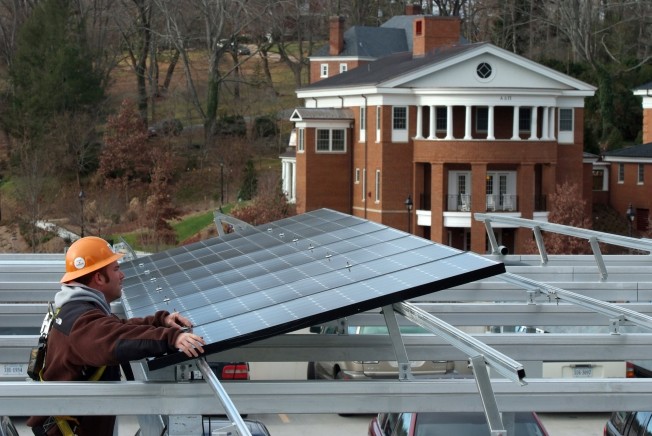
Protesting President Trump’s immigration policies in Lafayette Square, Washington DC. Photo by Ivy Main
Chances are, the people you know who call themselves environmentalists also celebrate racial diversity and think the U.S. should welcome immigrants and refugees. What, then, are we to make of white nationalists who invoke environmental concerns to justify acts of violence against immigrants?
Recent news articles tell us the suspect in the El Paso massacre cited overpopulation as a reason for killing 21 shoppers at a Walmart in the Texas border city. Latinos make up more than 82% of El Paso’s population, many of them Mexican-born. The suspect, Patrick Crusius, is said to have written a “manifesto” decrying Americans’ over-exploitation and degradation of natural resources.
“The American lifestyle . . . is destroying the environment of our country,” he wrote, before concluding, bizarrely, that therefore he should kill non-Americans.
Crusius is said to have drawn inspiration from an earlier mass shooting in Christchurch, New Zealand, where a white nationalist killed 51p eople at two mosques in the name of “eco-fascism.” He defined the term as “ethnic autonomy for all peoples with a focus on preservation of nature and the natural order.”
As a member of the Sierra Club for almost 40 years, I find this sounds familiar. Starting in the late 1980s, anti-immigrant forces tried to take over the environmental group, in an effort that wasn’t fully exposed and defeated until 2004. I remember the critical board election; the anti-immigration candidates made a plausible case for overpopulation as a root cause of much of what ails the environment, then and now. If you have fewer people around, after all, there’s only so much harm they can do.
Only, of course, the problem wasn’t—and isn’t—immigrants, it was U.S. laws that allowed native-born Americans to pollute our land, air and water. Keeping out immigrants isn’t a solution, it’s a non-sequitur. Realizing this, Sierra Club members firmly rejected the anti-immigrant slate of board candidates.
White nationalists aren’t just wrong in blaming immigrants for environmental ills. They also refuse to acknowledge that today’s most serious environmental challenges are global. Climate change, ocean acidification, the rapid loss of species—to name just a few—can’t be stopped by building walls and evicting non-white people.
This may be one reason many right-wing voters still reject the scientific consensus that climate change is a human-caused problem. The qualities most treasured by much of the radical right—self-sufficiency, male supremacy, physical strength, proficiency with weapons—aren’t useful in solving climate change. It’s human nature to disregard a problem you don’t think you have the tools to tackle.
Managing global problems requires international cooperation, respect for others, patience in the face of provocation, and empathy for those who are suffering. People of faith, humanists, and adults in general recognize these as higher-order virtues, but they are the first to be dispensed with in a zero-sum situation. People who believe the survival of their way of life requires other people to suffer do not ask themselves, “What would Jesus do?”
There is indeed a case for despair about the health of the planet. Bad news dogs us daily, from the deforestation of the tropics and the collapse of insect and amphibian populations, to the intensification of hurricanes and the plague of plastic waste. And then, of course, there’s the possibility that we have now passed a critical greenhouse gas tipping point and entered an age of runaway global warming.
But it isn’t fear of nature’s wrath that keeps me and other climate activists up at night. It’s the steady erosion of our conviction that we humans have it in us to rise to the enormous challenges before us.
Across the world, people are responding to resource scarcity and an increase in refugees not with compassion and generosity but with anger and distrust. Nationalism is confused with patriotism. Identity politics replaces communitarian values. Democracy is in retreat.
This is particularly maddening because, in fact, we know how to address the environmental challenges we face. We have the technology to quit fossil fuels. We can adapt to sea-level rise. We can make room for climate refugees. We can stop deforestation, and even reclaim deserts for trees. We don’t need to poison the earth to grow crops. We could end plastic waste tomorrow. We can’t bring back the species we’ve lost (at least not many of them), but we can do a much better job of protecting the ones we have left. Even reversing the rise in atmospheric carbon is conceivable, if we undertake to do it.
The question isn’t whether humans can do these things, it’s whether we will. Americans should be the ones leading the way, negotiating treaties with other nations, funding research, implementing solutions that benefit everyone, and keeping our doors open to the dispossessed.
That’s the sort of thing Americans used to do—not always, admittedly, but in hindsight we recognize those as our finest moments. We desperately need this sense of purpose again now, when the threats we face are existential.
But to do that, we have to reject a foreign policy grounded in selfishness and domestic policies that feed racism, xenophobia, and climate-science denialism here at home. There are no “other” people we can exclude, neglect or destroy to save ourselves.
There is only all of us, all across the world, and we are all in this together.
This article first appeared in the August 22, 2019 edition of the Virginia Mercury.
